|
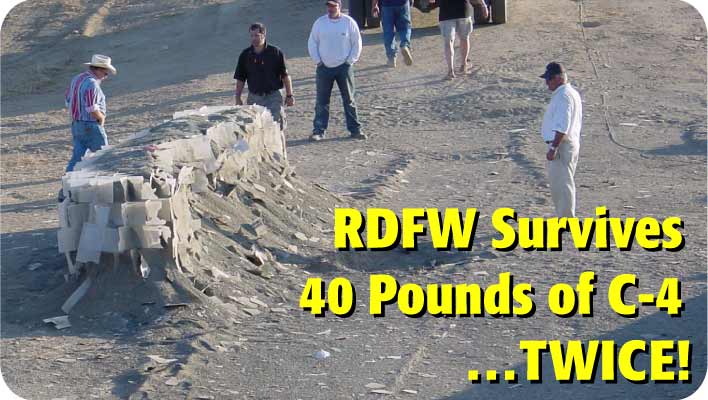
RDFW Survives Multiple Bomb Hits In Testing
Nov 07, 2005
In recent bomb blast testing in California, Geocell’s Rapid Deployment Fortification Wall (RDFW) survived a “double tap” by two successive hits at close range by 40-pound blocks of C-4 high explosives. An affordable new product helps give RDFW this unique survivability against multiple attacks.
Recent testing in California has demonstrated that RDFW, in conjunction with an affordable new product, can withstand multiple successive hits from large high-explosive charges.
The testing was carried out in early November of 2005 using 40-pound blocks of C-4 explosives. The explosive charges were placed just four feet from the wall and detonated one at at time. The wall sustained light damage in the two attacks and remained in place and upright, ready to defend against additional threats.
Check out the chronological photo layout below!
|
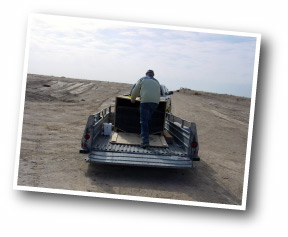
Start Construction
RDFW is shipped in crates of 100 units per crate. RDFW crates are designed to fit into the back of a Humvee. Each RDFW unit weighs 17 pounds.
|
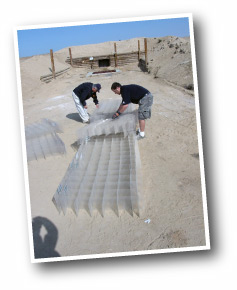 Rapid Deployment
Rapid Deployment
RDFW can be deployed by as few as two people. RDFW units are unfolded, stacked and nested, then locked together side-to-side. A crew of seven can build a wall 100 feet long and 4 feet high in one hour.
|
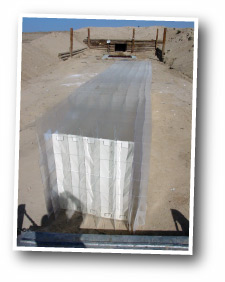
Wall Constructed
For this test, we constructed a wall 21 feet long and 4 feet tall. A wall this size requires 36 RDFW units. RDFW walls are 42 inches thick.
|
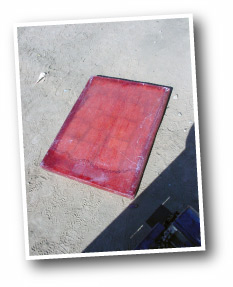
Panels
These panels consisted of a rugged outer shell and a filling of 3rd-party propietary explosion- and fireball-mitigative material.
|

Panels Added to RDFW Wall
Panels were added to the face of RDFW wall.
In this experimental installation, panels were attached to one another using screws and flanges; panels were attached to wall using zip ties. This process proved cumbersome, and greatly improved attachment methods have subsequently been developed.
|
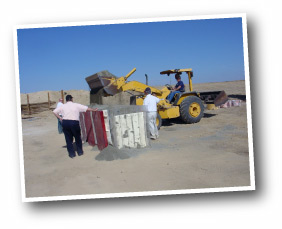
Filling RDFW With Sand
The completed wall was then filled with common sand. This wall was 21 feet long and 4 feet tall.
|
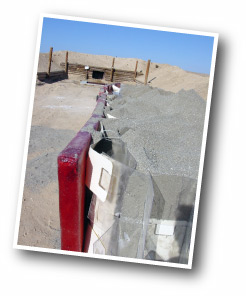
Gap Space Filled
It was decided that the 3-inch gap between the RDFW wall and the attached panels would be filled with sand.
|
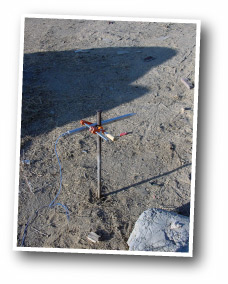
Sensor Installation
Pressure transducers were installed 30 feet from the center of the charge. One sensor was positioned to take data from the sheltered side of the wall. A second pressure transducer was positioned to measure the unobstructed shockwave.
|
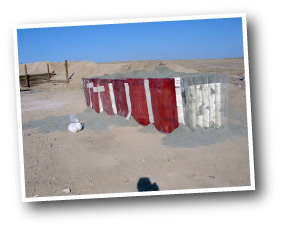
Explosives Placed
A 40-pound block of C-4 was placed at ground level 48 inches from the wall.
|
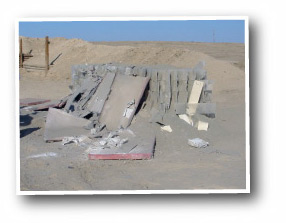 KaBOOM! KaBOOM!
The combination of RDFW with panels attached quite clearly survived this blast.
The panels nearest the charge were perforated and split open. Panels further from the charge were less damaged, and one panel at the end of the wall was thrown clear. The panel fill material had clearly been pulverized by the blast, as was predicted and desired.
|
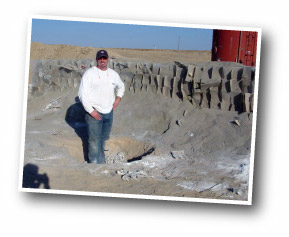
Crater
The C-4 charge left a crater approximately 40 inches across and 16 inches deep in the hardpan soil.
|
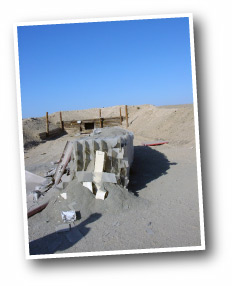 Deformation of RDFW Wall Deformation of RDFW Wall
The RDFW wall itself was deformed both vertically and horizontally. In the vertical axis, the wall has been leaned backwards about 12 inches, giving it a slant away from the blast. In the horizontal axis, the center of the wall has been pushed away from the blast about 14 inches, leaving a wall with a gentle curve to it.
|
 Little Damage to Front of RDFW Little Damage to Front of RDFW
The panels absorbed sufficient blast and thermal energy such that the plastic of the RDFW wall suffered little actual damage. A very small number of the RDFW plastic struts were cracked or broken off, but overall sand loss was negligible. The sand pile seen in this photo at the front of the wall is the sand which was held in the gap between the RDFW wall and the panels.
Note also the pulverized panel fill material (white powder) falling from the panel. Pulverization of this material is a clear indicator that panel filler material has absorbed shockwave energy and impulse as desired.
|
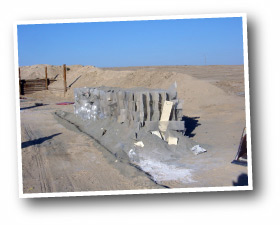 Hitting The Wall A Second Time Hitting The Wall A Second Time
Thanks to the panels, damage to the RDFW wall in the first blast was so minimal that it was decided to reuse this same wall for the second blast instead of constructing a new wall.
The second blast was conducted without panels in front of the RDFW wall in order to draw a comparison.
|
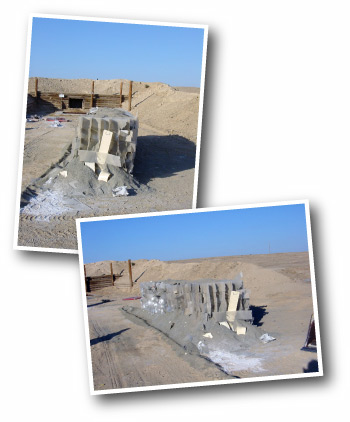
Setting Up For The Second Blast
In order to set up for the second blast, we used the bucket of the wheel-loader to simply push the RDFW back into an upright position. This was accomplished in just a few minutes.
|
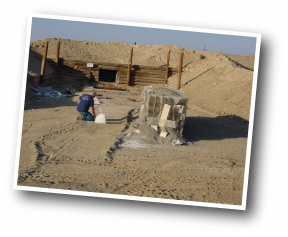 Same Charge, Same Standoff Same Charge, Same Standoff
To make a good scientific comparison between the two blasts, the second blast was conducted with the same charge, placed with the same standoff.
Note the absence of panels in this blast.
|
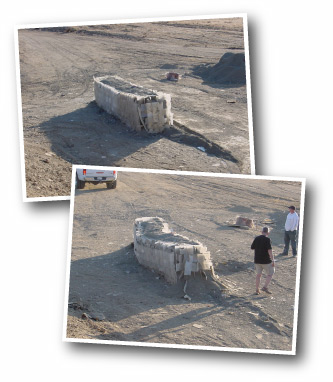 KaBOOM! KaBOOM!
The RDFW wall clearly survived this second blast, albeit with some damage. The wall remains standing at full height as a defensive barrier.
The second blast produced similar—but greater—deformation of the RDFW wall. The wall was again leaned backwards and bowed into a gentle arc.
Maximum wall deformation in the first blast was measured at 14 inches. In this second blast, maximum RDFW wall deformation was measured at 19 inches.
|
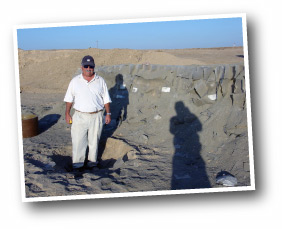
Same Crater
This second blast produced a crater of about the same size and depth as the first blast.
|
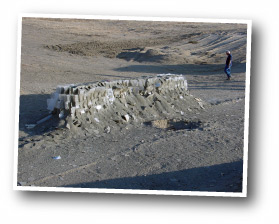 Some Damage To Front of RDFW Wall Some Damage To Front of RDFW Wall
The second blast produced greater damage to the front face of the RDFW wall than the first blast.
In the portion of the RDFW wall nearest the charge, the front two rows of plastic struts have been destroyed. The loss of these two rows of sand-retaining plastic means that, essentially, the 42-inch-thick RDFW wall has been reduced to a thickness of 31.5 inches. Still, this 31.5 inch inches of contained sand continues to present a formidable barrier.
|
|




















